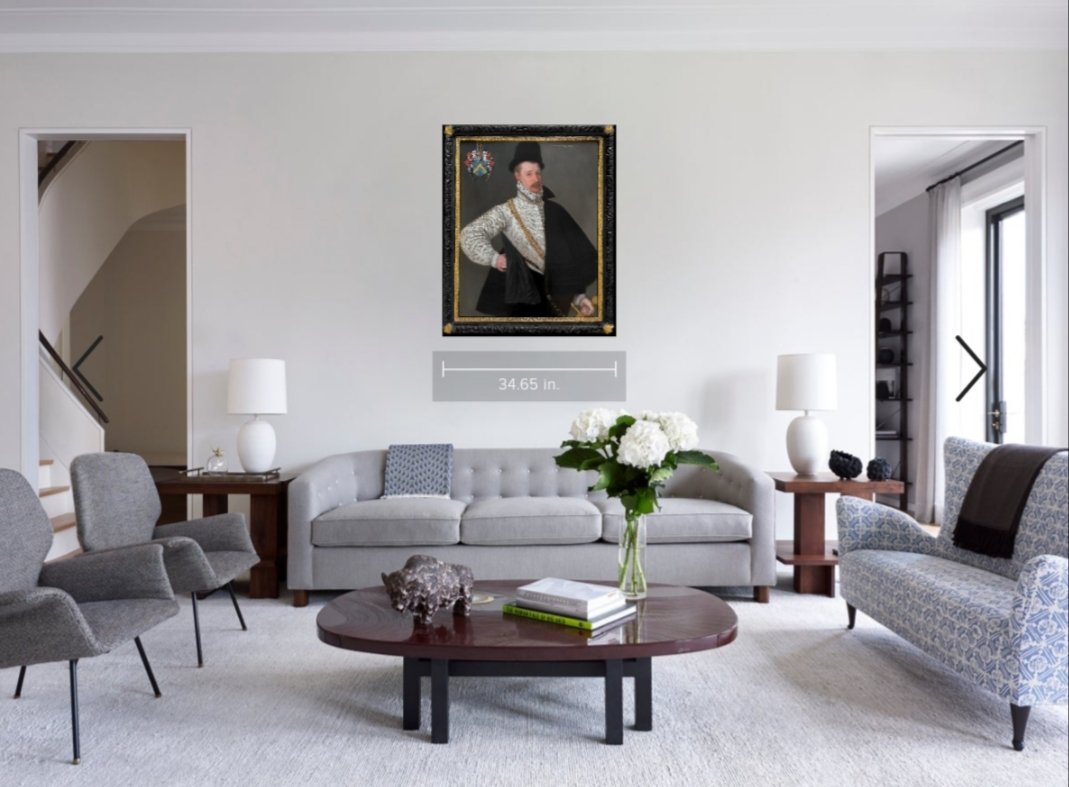"Portrait De Richard Tomkins (c.1532-1603) Vers 1575; Ecole Anglaise Du XVIe Siècle"
This exquisite oil on panel portrait descended from the sitter through the family for almost 450 years, until recent. It is a splendid survival from the Elizabethan era - the golden age in England’s history.Portraiture occupied a central place in 16th century British painting. Artists portrayed their clients in the manner set out by the terms of the commission. The main requirement was a good likeness, but restricted to the physical features of the sitter, character not being considered worthy of notice. They were almost always intended to convey the sitter’s social status and rank in society – propaganda portraits. The fundamental principle governing all Tudor and Jacobean portraits is the recording and defining in visual terms the position of a sitter in society. The expensive fabrics, the attire, and the grand coat-of-arms as seen in the present portrait proclaim to every onlooker that this is a superior being. In Elizabethan collections there was a total absence of painter’s names and they were often unrecorded and deemed unimportant. This confirms that to the Elizabethan mind the recording of human likeness was connected with this concept of fame and social rank and the motivation of the great collections of the time was not aesthetic but dynastic; the idea of a painting as a work of art never existed, it was primarily an expression of rank and class. Painting was considered a mechanical skill – a trade – however this began to change at the close of Elizabeth’s reign.
In England most artists were foreigners who came in search of commissions in a country with few native painters yet within this general trend a native school of painting was developing. Nicholas Hilliard, who was Queen Elizabeth I’s limner, is a widely recognised figure but so too is the fashionable London portait painter George Gower (fl.c.1540-1596), and Robert Peake (1551-1619).
This magnificent portrait was painted during the last quarter of the 16th century – the Elizabethan era – the golden age in English History when Queen Elizabeth I was on the throne. The portrait represents the noble gentleman Richard Tomkins who was described by the bishop of Hereford as ‘a man very well affected in religion’. Richard’s precise date of birth is unknown but we know that he was 43 years of age when the portrait was painted according to the inscription.
Richard was born in Herefordshire and was a son of James Tomkins (1490-1561) who was a royal collector of revenue, and his second wife Margaret Kettleby (born 1520). Although Richard’s ancestors were amongst the Herefordshire gentry by 1433, they were not major freeholders until 1535 when his father bought the manor of Monnington, about 16 miles from Leominster (by 1553 the latter also acquired Garnston manor (sold in 1661) in the parish of Weobley).
Richard married Catherina de Baskerville, the daughter and coheir of James Baskerville of Kyre Park, Herefordshire, and it is thought that the couple had thirteen children.
Richard, like his father, was a royal officer responsible for taking ‘escheats’ from deceased subjects (a law that transfers the property of a person who has died without heirs to the Crown or state so that property is not left without recognised ownership). Richard was made Sherriff on 16th Nov 1592. He died in 1603 and was succeeded by his eldest son James (c.1569-1636), an English politician, who inherited the manors of Monnington (the chief seat of the family) and Garnston, a considerable domain south of Weobley. James was an MP for Leominster in 1623 and married the cousin of the 1st Earl of Cork. James was hanged in 1643 for raising an army for the King against Parliament, and was succeeded by his son William.
The clothing depicted was fashionable attire for a wealthy gentleman of the period - the small turned-over collar, slashed doublet, capotain hat (which was worn indoor as well and outdoor), and hip length cloak. The cape is slung fashionably over one shoulder and is often depicted in this manner in portraits at this time. The collar is embroidered with beautiful ‘blackwork’ embroidery featuring large designs of flowers, fruit, and other patterns connected by curvilinear stems – this was a popular motif in England from the 1570’s and is a wonderful survival.
Monnington Court was built in the 14th century but later extended and remodelled. The original timber-framing was probably replaced by stone in the 18th century. The manor contains enriched cornices and friezes, two grotesque caryatides, two shields of the arms of Tomkins, one supported by two cherubs and the other held by an angel, a crest of the same family, the inscriptions T. and L.T., 1656 (twice repeated), "Crimini(e) mundatus, semper transire pe(a)ratus" and "Vive Deo gratus, toti mundo tumulatus.". The manor contains a moot hall, completed before 1230 - a meeting place traditionally to decide local issues. Monnington Church nestles behind the Court, with no road access and bordered by water on three sides. Originally a thirteenth century church, it was rebuilt by our sitter’s great-grandson, Uvedale Tomkins in 1679. It is still lit by oil lamps. Like a great many Herefordshire villages, Monnington was staunchly Royalist, and a grand Royal Stuart Arms mounted high on one wall, to celebrate the restoration of the monarchy, bears witness to that fact.
The portrait is endowed with an elaborate coat of arms of the Tomkins family. The rapid population growth and the unprecedented opportunities to acquire land and office during the Elizabethan period opened the gateway to individual advancement wider than ever before. With those factors came fierce competition for individual recognition and status. The use of the coat of arms serves to underline this family’s wealth, importance and lineage.
This is a fine example of early English oil on panel portraiture.
Provenance: By descent in the Baskerville family until recently representing around 450 years of family ownership
Measurements: Height 107.5cm, Width 88cm framed (Height 42.25”, Width 34.75” framed)




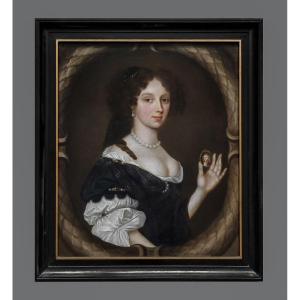


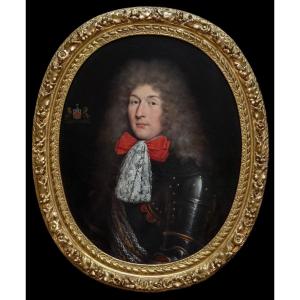
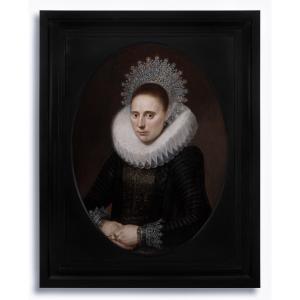

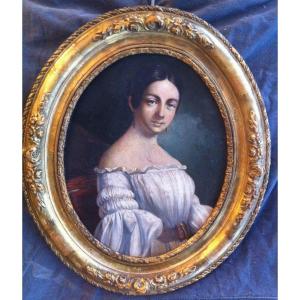
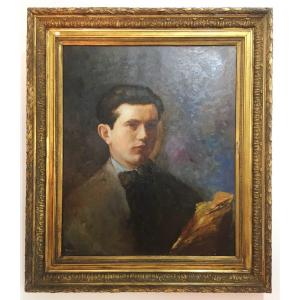



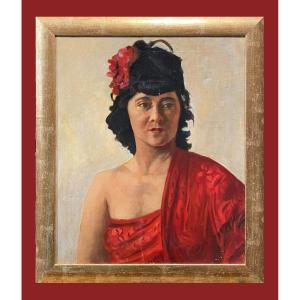




 Le Magazine
Le Magazine Rivista Artiquariato
Rivista Artiquariato TRÉSORS magazine
TRÉSORS magazine

